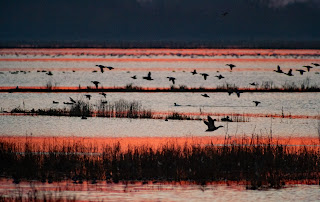Amongst the Goldfinches feeding on the Elders a few Siskins, twisting around amongst the few leaves remaining on the trees.
A celebration of birding and natural history, generally within a 10 mile radius of Ely Cathedral, Cambridgeshire, UK. It would be great if you wanted to share your Ely 10 birding news, experiences, photos, art and video through this blog. Please contact hairyfolkster@gmail.com with your post or to join the authorship, I'll get you on the list quicker than a fly over Alpine Swift.
Thursday 24 December 2020
Stone Free
Amongst the Goldfinches feeding on the Elders a few Siskins, twisting around amongst the few leaves remaining on the trees.
Tuesday 15 December 2020
The Bulls
Monday 14 December 2020
Slam'dunking into the Top Two - three records by Dusky Springfield - 'The look of dove', 'This gull's in dove with you', and 'Sunbird a Preacher dove'

Sunday 13 December 2020
The Declining Winter
Sunday 6 December 2020
Sunday 15 November 2020
Hot Legs
Do It All Over Again
Bonkers
At One With The Birds (again)
Spryte Flight
Part of the daily routine now at work is an hour most mornings managing the staggered and distanced arrival and departure of 700 or so kids and adults through the school gates.
As I walked across the playground to open up the gates a Chiffchaff hueeted from the sunsoaked ivy clad ashes that border that side of the school. "Shame it's not a Yellow-brow" I thought. Almost in synchronisitous response the feisty "tzuuuet" call of a Spryte pierced the air, calling a couple of times. I had to get on with the job in hand and unlocked the gates for the afternoon pick up, perhaps the steady flow of folk through the playground encouraged it and the Chiff to move on as I heard nothing from either of them again.
Saturday 24 October 2020
Chrome Waves
Friday 16 October 2020
Friday I'm In Love
https://www.youtube.com/watch?v=mGgMZpGYiy8
When I first saw this illustration, many years ago, I fell in love with the idea of Skuas flying over Ely. Graham Easy's pen work belies a passion for unlocking the secrets of overland Skua passage over Cambridgeshire. His observations have led to the understanding that strong autumnal North Westerly winds, coupled with squally showers and rain can encourage Skuas to build in numbers in the Wash and continue their passage, not along the coast as is the norm but within eyesight, inland along the courses of the Rivers Ouse and Nene before heading onwards towards the River Severn and out into the Atlantic via the Bristol Channel. This passage is likely to occur in fine weather too but the Skuas can fly high, beyond ready detection.
I didn't give up and with the sun lowering a svelte dark bird appeared to the south of the cathedral, it banked to circle and it's form became clear, an Arctic Skua - little plumage but all jizz, as I watched another appeared beneath it, towering upward like dark lights being switched on another appeared and another. In total 12 skuas kettled and span around each other, not unlike the Sandwich Terns had done earlier. I'd seen flocks of resting skuas take to the wing and do this offshore before, heading up high and ready to move. As the wind took them into the glare of golden clouds reflecting the dropping sun each blinked away out of sight - dissappearing as suddenly as they had appeared, magical.













































